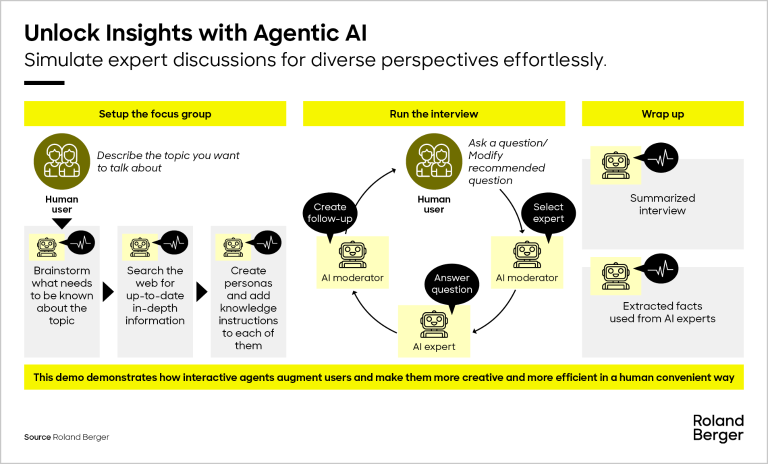Digital transformation can be a complex process. Roland Berger can guide you through each aspect - and unlock your organization's full potential.


AI-driven pricing: Better technology, better returns
How to leverage the power of new generative-AI pricing tools to optimize pricing strategies
While AI-powered dynamic pricing is already established in some industries, cutting-edge generative AI models promise to supercharge pricing strategies across the board. We look at how these readily available tools can quickly enhance pricing decisions, enable new capabilities and improve competitiveness.

"These readily available strategic pricing technologies can be used in any industry, with immediate results."
Over the past few years, data-driven pricing models have helped transform pricing strategies in several industries, most notably retail. Machine learning algorithms analyze vast amounts of data in real-time to optimize pricing decisions and maximize returns. However, these tools rely on high frequency, structured data, limiting their use to certain industries.
The dawn of generative AI -powered pricing changes all this – and opens up a world of new opportunities. Novel GenAI pricing methods that leverage large language models (LLMs) not only enhance traditional data-driven models. They also enable next-level AI capabilities such as sentiment-driven pricing (where customer perceptions are used to influence pricing decisions), automated analysis and drafting of pricing contracts and agentic AI systems (where AI agents automate multistep processes). And because they can draw on unstructured as well as structured data sources, these readily available strategic pricing technologies can be used in any industry, with immediate results. This makes them a highly effective profit lever.
In this article we look at the capabilities, use cases and benefits of GenAI-powered pricing methods, including outlining two examples and how Roland Berger can assist with their implementation.
A strategic pricing transformation
Global trends in pricing in recent years have highlighted the need for data-driven pricing strategies . The rise of sustainability premiums, subscription models, inflationary pressures and volatile commodity prices, for example, are forcing companies to adapt to remain competitive. AI and data analytics are enabling this shift, helping to optimize prices, boost profitability and meet demand.
GenAI-powered pricing methods build on traditional data-driven price models added value by allowing companies in any industry to comprehensively understand customers, competition, market trends and more. Use cases can be found all along the pricing journey.
"All of Roland Berger’s pricing project options typically deliver short-term payoffs, with high total ROIs."
How they work: Examples of GenAI-powered pricing methods
The technology works by seamlessly combining multiple real-time data sources, both structured (cost data, sales data, customer data, etc.) and unstructured (customer feedback, social media activity, expert opinions, etc.). This facilitates real-time competitor analysis, multi-channel data gathering, nuanced customer sentiment analysis and highly personalized pricing recommendations. There are several applications for GenAI in pricing; below we outline two examples.
Pricing-perception analysis
Roland Berger offers a custom-made approach that allows clients to use customer perceptions of their prices to influence their pricing decisions. By feeding unstructured customer data - such as customer reviews - to large language models (LLMs), key pricing themes can be identified. This enables data-driven pricing decisions, the development of new pricing algorithms, and even the embedding of automated feedback loops into operational pricing. The impact is immediate – increased revenue, improved customer satisfaction and a stronger market position.
Key benefits of pricing-perception analysis:
- Stay ahead of the curve: Uncover emerging trends or customer needs early
- Performance insights: Derive the best measures to address negative drivers. For example, which local branches of our business do we need to prioritize/have the greatest potential?
- Steer customer thinking: Evaluate the effectiveness of marketing campaigns to influence customer perception and purchasing behavior. For example, if real-time feedback shows a promotion is not working, it can immediately be tweaked and the feedback included in the pricing model for the next promotion
- Customized offerings: Assess regional variations in customer preferences and tailor promotions or inventory accordingly.
Agentic AI
Another, cutting-edge example of GenAI in pricing is agentic AI. Here, AI agents automate processes requiring several steps, where each step was previously carried out by different people. If tasks are very complex, the agents can work as a team, forming a large conglomerate. A use case would be developing marketing personas to determine how each values a particular feature or service.
Key benefits of agentic AI:
- Dynamic pricing automation: Enable automated, data-driven pricing strategies for products, brands and beyond
- Enhanced customer segmentation: Seamlessly incorporate advanced pricing insights into customer and market segmentation
- Real-time precision: Drive real-time pricing for better differentiation, accuracy and responsiveness
How Roland Berger can help
Roland Berger offers several pricing project options to clients, each tailored to a different level of maturity and need. The pricing due diligence option assesses a client’s pricing strategy and AI readiness to derive the most impactful quick wins. The pricing boost package helps to develop solutions for specific pricing strategies, delivering targeted improvement actions. And the fully fledged pricing transformation option supports the development and implementation of an end-to-end pricing strategy. All options typically deliver short-term payoffs, with high and short-term ROIs.
For more information about any of the options, or to discuss your individual pricing needs, please contact one of our experts. We look forward to hearing from you.


_image_caption_none.png?v=1392887)



